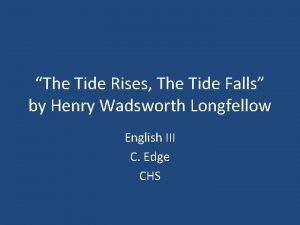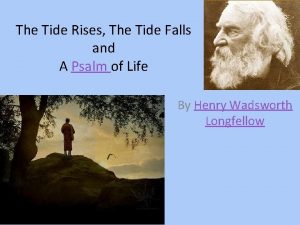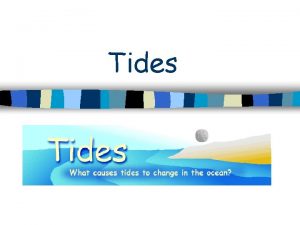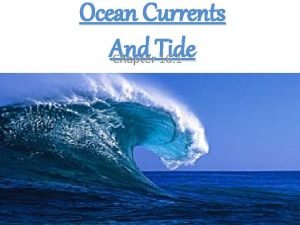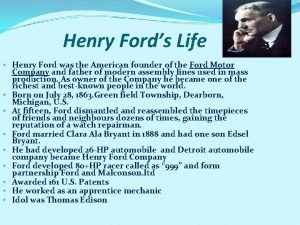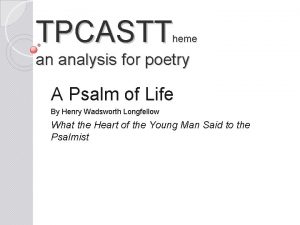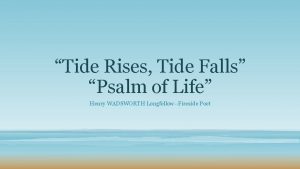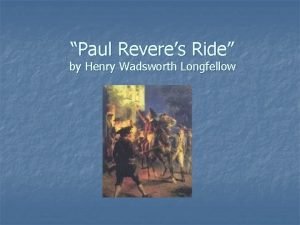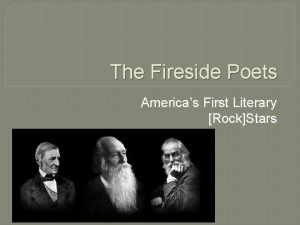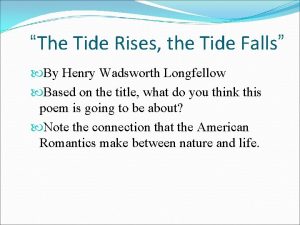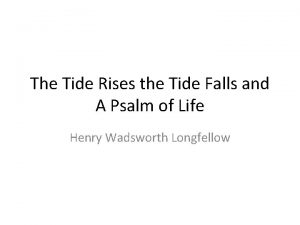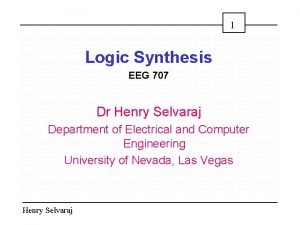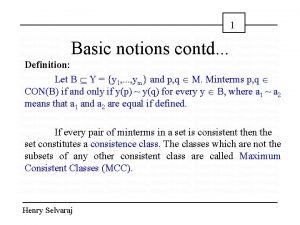Tide Rises Tide Falls Psalm of Life Henry













- Slides: 13

“Tide Rises, Tide Falls” “Psalm of Life” Henry WADSWORTH Longfellow--Fireside Poet

Warm Up: • https: //www. youtube. com/watch? v=Nv. BI_Hl. Py. G 8 • How does this video exemplify the romanticism movement/ideals? • How does this relate to “Thanatopsis, ” the poem from yesterday?

Longfellow Bio– Find the following info: • Read the Author Biography on Henry Wadsworth Longfellow on page 342 of your textbook, and list 5 interesting facts you learned about him below (at least 2 of your facts should be about his writing). 1. 2. 3. 4. 5.

“The Tide Rises, The Tide Falls” p. 346 • What is the literary movement of Longfellow? What else do we need to know about him? • What happens in the first stanza? What time is it? • What happens in the second stanza? What time is it? • What happens in the third stanza? What time is it? • What images does Longfellow use to show natural acts (besides the tide rising and falling)? • What images does Longfellow use to discuss human acts?

Compare/ Contrast to “Psalm of Life” • With a partner read both poems and fill in the figurative language and themes charts for both poems • Work to compare the two poems in a Venn diagram “Psalm of Life” “Tide Rises, Tide Falls” Similarities Differences

Analytical Body Paragraphs • We can still use the Toulmin model. • CLAIM: The topic sentence for an analytical BP. It will claim the interpretation of the literary text that you intend to prove. • This could serve as a thesis or as the topic sentence of the paragraph. • GROUNDS: Still just the evidence. Incorporate evidence into your sentences so it feels natural. • This would be the textual evidence from your passage/text. • WARRANT: Explains how the grounds proves your claim or, in a longer essay, relates back to the overall thesis in the introduction. • Why does this matter? How does this quote support what you have stated?

Practice Writing PROMPT: In a well-constructed and self-contained paragraph, analyze how Longfellow encourages his audience to live life to its fullest in “A Psalm of Life. ” • Note something about this prompt and what it’s not asking you. • It’s not asking you to prove that Longfellow encourages his audience to live life to its fullest. • That’s the accepted fact. There’d be analysis in proving that Longfellow encourages his audience to live life to its fullest. • It’s asking you to prove the literary techniques Longfellow uses to encourage his audience to live life to its fullest.

• CLAIM: Life, for Longfellow, is not something to be taken lightly, and he encourages his audience to look at it seriously. • Find grounds to support this claim. I’ll give you a second. • GROUNDS: Longfellow emphatically exclaims that our lives are “real” and “earnest” (5). • GROUNDS: Longfellow metaphorically compares life to a “battle” that can only be won by “a hero” (17, 20). • GROUNDS: Longfellow forces his audience to confront their own mortality. His use of simile in comparing the beating of “our hearts” to a “[f]uneral” dirge is unyielding (15, 16). • Warrant? • WARRANT: This comparison forces the audience to realize how serious life is. It’s not something to be taken lightly; it will end, and by confronting that mortality, the audience is more likely to realize that Longfellow’s exhortation—that we should “be up and doing”—is the only way to life a full life (33)

All Together… Life, for Longfellow, is not something to be taken lightly, and he encourages his audience to look at it seriously. Longfellow forces his audience to confront their own mortality. His use of simile in comparing the beating of “our hearts” to a “[f]uneral” dirge is unyielding (15, 16). This comparison forces the audience to realize how serious life is. It’s not something to be taken lightly; it will end, and by confronting that mortality, the audience is more likely to realize that Longfellow’s exhortation—that we should “be up and doing”—is the only way to life a full life (33).

Your Turn: • Try the same approach with “A Tide Rises, A Tide Falls”. • Prompt: How does Longfellow show his audience that Nature is an everlasting entity?

Recap Poems • How does this video exemplify Longfellow’s theme in both poems? • http: //youtu. be/U 0 xs 0 he. OP 8 c

Create a Romantic Hero • On your own, turn to P. 317 • After reading about the Romantics, develop your own Romantic Hero! • Draw what this hero would look like and write a paragraph to describe how they exemplify key aspects of the romantic time period!

Closure • Present your romantic heroes! • Discussion Response- Q & A • Think about the price of progress, not the dollar amount, but what you actually have to give up for the progress of a society. • Think of a couple examples of progress in your lifetime and the cost of this progress. Elaborate with detail.
 The tide rises the tide falls meaning
The tide rises the tide falls meaning The tide rises, the tide falls
The tide rises, the tide falls When the tide rises quote
When the tide rises quote The difference between spring tides and neap tides
The difference between spring tides and neap tides Neap and spring tides
Neap and spring tides Essentials of oceanography
Essentials of oceanography Neap tide spring tide
Neap tide spring tide Psalm 121 psalm 23
Psalm 121 psalm 23 What did henry hudson sail for
What did henry hudson sail for What were henry ford's accomplishments
What were henry ford's accomplishments A psalm of life poem analysis
A psalm of life poem analysis Venn diagram of psalm of life
Venn diagram of psalm of life A psalm of life tpcastt
A psalm of life tpcastt A psalm of life tpcastt
A psalm of life tpcastt
